


The oldest coins of Crete, so far as they have been identified, cannot be assigned to an earlier period than circ. B.C. 500 (cf., however, A. Evans on Minoan weights and currency in Corolla Num., p. 336 f.), while the most important period of coinage is from circ. B.C. 400 to 300. The autonomous issues cease about B.C. 67 with the conquest of Crete by Q. Caecilius Metellus. Imperial coins were struck at some of the principal cities of the island, and there was also an issue of money for the Province of Crete generally.
The usual standard is the Aeginetic, the chief denominations being the stater or didrachm and drachm. After the age of Alexander the Attic standard gradually replaces the Aeginetic. It is probable that Alexan- drine coins circulated in Crete, though only a few of the mint-symbols have been satisfactorily made out. About B.C. 200 many of the cities (see under Cnossus) struck imitations of the Athenian tetradrachm with their own names and symbols.
The Cretan cities furnish many remarkable examples of fine coin- engraving, notably Cnossus, Cydonia, Gortyna, Phaestus, and Sybrita, and two engravers, Neuantos and Pythodoros, record their signatures on the money of Cydonia, Aptera, and Polyrhenium. R. S. Poole (N. C., 1864, p. 240; cf. Gardner, Types, p. 161) has called attention to the frequent portrayal of animal and vegetable subjects in Cretan coin-art and its fondness for perspective and foreshortening. Everywhere, however, side by side with these fine coins, there exist unskilful copies and even the most barbarous reproductions—see, for example, the various copies of the fine Gortynian didrachm representing Europa in the tree (B. M. C., Crete, Pl. IX. 5-10). Any large collection of Cretan coins has therefore a somewhat bizarre appearance, and the crudities of style and fabric are emphasized by the common practice of the Cretan mint-masters of employing the coins of other places—Cyrene, Argos, Euboea, &c.—as flans on which to restrike their own designs. Such restriking, however, often offers to the numismatist a useful clue to the chronological arrangement of the coins.
The types are of great interest, especially when they embody such distinctively Cretan myths and persons as those of Minos, the Minotaur, and the Labyrinth at Cnossus; Europa at Gortyna; Herakles, Velchanos, and Talos at Phaestus; and the local heroes of Aptera and Cydonia. The principal gods represented are Zeus (cf. N. C., 1893, p. 237) and Artemis, the latter often in the local forms of Diktynna and Britomartis. Apollo, too, is of frequent occurrence, sometimes apparently in the character of a hunter’s god, the patron of those who pursued the wild goat of the island. Demeter, Hermes, Dionysos, &c., are also found.
| Young male head (rude style). | Æ .9, &c.
|
| Horn of goat; in field, palm-branch. | Æ .55
|
| Ω i.e. ΑΝΩπολιτων. No type. Æ .5
|
Apollonia, near Cnossus (?) (Svoronos, p. 7; Eph. Arch., 1889, p. 195).
| Head of Apollo. | ΑΠΟΑ Stern of vessel with aplustre
[B. M.]. Æ .5
|
| Id. | [Α]Π Aplustre and palm-branch. Æ .6
|
Aptera, on the north coast, near Cydonia.
| ΑΠΤΑΡΑΙΩΝ (or ΑΠΤΕΡΑΙΩΝ) Head of the Artemis of Aptera with ornamented stephane; on some speci- mens, artist’s name ΠΥΘΟΔΩΡΟΥ. | ΠΟΛΙΟΙΚΟΣ (sometimes ΠΤΟΛΙΟΙ-
ΤΟΣ) Armed warrior standing with
r. hand raised to salute a sacred tree
AR Stater.
|
| Id. | ΑΠΤΑΡΑ Bow. AR ½ Dr.
|
| Id. | Id. Æ .5
|
The hero called Πτολιοικος is perhaps the oekist (πολεως οικιστης) Apteros or Pteras (Paus. x. 5. 9 and 10; B. M. C., p. xxx). The artist, Pythodoros, also signs coins of Polyrhenium.
| Head of Apollo. | ΑΠΤΑΡΑΙΩΝ Warrior standing fac-
ing [Svor., p. 20, No. 39] AR Stater.
|
| Head of the Artemis of Aptera. | ΑΠΤΑΡΑΙΩΝ Warrior advancing.
AR ½ Dr.
|
| Id. | „ Apollo seated; lyre be-
hind. AR ½ Dr.
|
| Head of Zeus. | „ Hermes standing
AR ½ Dr.
|
The bronze coins have on obv. Head of Artemis; rev., Torch; Three
torches crossed; Torch and arrow-head; Bee; Lyre; Dove; Bearded
term; ![]() (i. e. Aptera); Warrior standing facing (with obv. Head of
Apollo), &c.
(i. e. Aptera); Warrior standing facing (with obv. Head of
Apollo), &c.
Arcadia, an inland town between Cnossus and Gortyna.
| Head of Zeus Ammon. | ΑΡΚΑΔΩΝ Athena standing, armed.
AR Drachm.
|
| Id. | Æ .5-.4
|
| Head of Zeus. | ΑΡΚΑΔΩΝ Athena standing, armed;
laurel-wreath [Bodleian Libr., Eph.
Arch., 1889, Pl. II. 9].
AR Tetradr. 231 grs.
|
Arsinoë, apparently near Lyttus (see Svoronos, p. 29, on Steph. Byz.).
| Head of Athena. | ΑΡΣΙ Two dolphins. Æ .6-.4
|
(On the attribution to the Cretan Arsinoë see Svoronos in Journ. Int., 1904, p. 397 f.) Cf. Methana (p. 442).
Axus, to the north of Mount Ida and south-east of Eleutherna.
| Head of Apollo (usually of rude style). | AR Stater, Drachm, ½ Drachm.
Also Æ with CΑΞΙΟΝ. |
| Head of Apollo. | FΑΞΩΝ Tripod.
AR Didrachm, Drachm, Obol.
|
| Head of Zeus. | CΑΞΙΩΝ Tripod. Æ .75 and smaller.
|
| Head of Artemis. | CΑΞΙΩΝ Fulmen. Æ .4
|
| Head of Zeus. | F Α Tripod; above, fulmen and ΚΡΑ.
AR ½ Drachm
|
| Id. | CΑΞΩΝ Tripod; above, fulmen.
Æ .5
|
| Id. | Α Ξ Tripod. Æ .75
|
| Id. | Α Ξ Fulmen. Æ .75 and smaller.
|
Imperial—Tiberius to Caligula. Inscr., Ε(πι) ΚΟ(ρνηλιου) Λ(υπου); rev. ΚΡΗΤΕΣ ΑΞΙ ΣΥΝΚΛΗΤΩ Head of the Senate, bearded and veiled, AR 118 grs. (Paris); and ΚΡΗΤΕΣ ΑΞΙΩΝ,—ΕΠΙ ΛΑΧ(ητι) Heads of Caligula and Germanicus, AR 33 grs. (Hirsch, Auctions-Cat., xiii. 2912). Cf. Cydonia, p. 464.
Biannos or Biennos (Viano), in the southern part of Crete between Priansus and Hierapytna.
| Female head (Artemis ?) | ΒΙΑNΙ Rose [B. M.]. Æ .55
|
| Id. | ΒΙ in dotted circle [Svor., p. 43]. Æ .45
|
| Head of Artemis with quiver. | ΚΕΡΑΙΤΑΝ Arrow-head and spear-
head within wreath. AR Drachm.
|
| Head of Artemis. | Κ Arrow-head and spear-head [B. M.].
Æ .6
|
| Head of Apollo. | ΚΕ Similar. Æ .7
|
Chersonesus or Cherronesus (Chersoneso), on the north coast near Lyttus, had a temple of Britomartis (Strabo x. p. 479).
| Head of Britomartis, laur. | ΧΕΡΣΟΝΑΣΙΟΝ Apollo, naked, seated
on omphalos holding lyre; in field,
thymiaterion. AR Stater
|
| Head of Britomartis. | ΧΕΡΣΟΝΑΣΙΟΝ (or ΧΕΡΣΟ) Hera-
kles striking with uplifted club.
AR Stater usually of rude style
(copied from stater of Stymphalus, p. 454 supra). |
| Head of Athena. | ΧΕΡΣΟ... Eagle [Ephem. Arch., 1889,
p. 199]. AR ½ Drachm.
|
| Id. | ΧΕΡΣΟΝΑΣΙΩΝ Eagle. Æ .45
|
| Id. | ΧΕΡ (or ΧΕ) Prow. Æ .7-.45
|
| ΧΕΡ | Eagle. Æ .65
|
Other Æ types, Head of Zeus; Arrow-head (inscr., ΧΕ).
Cnossus, in the northern part of the island near Lyttus. Its types chiefly relate to Minos and the Minotaur, and to Zeus and Hera, whose marriage was commemorated at Cnossus by a festival of the ιερος γαμος.
| Minotaur running, holding stone in each
band. [Babelon, Traité, pt. 2, 1. No. 1968.] |
Labyrinth of cruciform maeander pat-
tern; in centre, star; at each corner,
deep square depression. AR Stater.
|
| Id. with inscr. ΚΝΟΜ. | Similar [N. C., 1896, p. 90] AR Stater.
|
| Minotaur running. | Star in inc. sq., within ornamental frame
[Babelon, Traité, No. 1972].
AR Triobol.
|
| Minotaur running, inscription ΚΝΟ- ΜSΟ(N). | Square labyrinth of maeander pattern
(Ephem. Arch., 1889, p. 199, No. 13)
AR Stater.
|
| Minotaur running, holding stones. | Beardless bead (Theseus ?) within square
frame of maeander pattern. (the
labyrinth). AR Stater.
|
| Id. | Square labyrinth of maeander pattern.
AR Stater.
|
| Id. | Star within ornamental frame
AR Dr., ½ Dr., Obol.
|
| Female head (Ariadne ?) in maeander frame. | ΚΝΩΣΙΟΝ Zeus seated, holding phiale
and sceptre [Svor., Pl. IV. 33].
AR Stater.
|
| ΚΝΩΣΙΟΝ Head of Demeter or Perse- phone in maeander frame. | ΜΙΝΩΣ Minos seated on throne, hold-
ing sceptre [Berlin. Svor., Pl. IV.
34]. AR Stater.
|
| Head of Demeter or Persephone. | ΚΝΩΣΙΟΝ Zeus seated, holding phiale
and sceptre; whole in maeander pat-
tern. AR Stater.
|
| Id. | Labyrinth of maeander pattern formed
like the swastika; in centre, star.
(Also with labyrinth of square form,
sometimes inscribed ΒΡΙΩΝ).
AR Stater.
|
| Id. | ΚΝΩΣΙΟΝ (or ΚΝΟΣΙΟΝ) Bull's
head in maeander frame. AR Stater.
|
Small bronze usually with a head (Demeter, Zeus, &c.) on each side. Some of the AR have a curious countermark (pomegranate (?) within circle of dots), found also on the coins of several other Cretan cities (cf. Svoronos in Bull. corr. hell., xii. p. 410, explaining it as a lebes; see also Th. Reinach, L'hist. par les monn., p. 27 note).
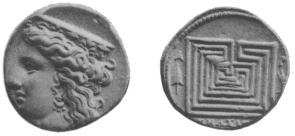
| Head of Hera, wearing stephanos with floral ornaments (Fig. 243). | ΚΝΩΣΙΩΝ Square labyrinth, usually
with Α on l. and Ρ on r.; also with
symbols, spear-head and fulmen.
AR Stater, Drachm, Tetrobol.
|
| Head of Apollo. | ΚΝΩΣΙΩΝ Male figure (Minos?), seated
on square labyrinth holding Nike and
sceptre. AR Drachm.
|
| Id. | ΚΝΩΣΙΩΝ Square labyrinth.
AR ½ Drachm; same types Æ.
|
| Star. | Square labyrinth. Æ .4
|
| Head of Athena. | Id. AR ½ Drachm.
|
| Europa, with inflated veil, riding on bull; beneath, dolphins; border of rays. (type of Gortyna). | ΚΝΩΣΙΩΝ Square labyrinth; symbol,
star. Æ .75-.6
|
Coins of the last described type were probably first struck in B.C. 220,
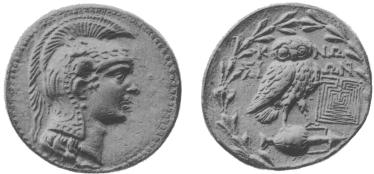
| Head of Athena (as on coins of Athens) (Fig. 244). | ΚΝΩΣΙΩΝ. Owl on amphora; symbol,
square labyrinth; all in olive-wreath.
AR Attic tetradrachm.
|
Similar imitations of Athenian tetradrachms appeared circ. B.C. 200 at various Cretan cities, Cydonia, Gortyna, Hierapytna, Lappa, Polyrhenium, and Priansus. These types may have been adopted for commercial rather than political reasons (cf. N. C., 1884, p. 26 f.).
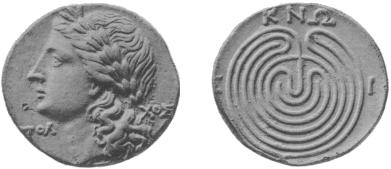
| Head of Apollo laur. ΠΟΛΧΟΣ (magis- trate’s name?) (Fig. 245). | ΚΝΩΣΙΩΝ Circular labyrinth.
AR Attic Tetradrachm.
|
| Head of Apollo. | ΚΝΩ Square labyrinth [Hunter Cat.,
II. p. 176]. Æ .85
|
| Head of Zeus Ammon, bearded. | ΚΝΩΣΙΩΝ Square labyrinth.
AR Drachm.
|
| Head of Zeus Ammon, beardless. | ΚΝΩΣ Fulmen between two stars.
Æ .8
|
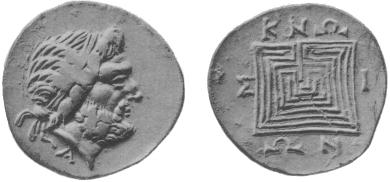
| Head of Zeus (or Minos); some speci- mens restruck on AR of Antiochus IX. Cyzicenus, B.C. 116-95 (Fig. 246). | ΚΝΩΣΙΩΝ Square labyrinth.
(Fig. 246) AR Attic Tetradrachm.
|
| Head of Zeus. | ΚΝΩΣΙΩΝ Square labyrinth.
Æ .9-.55
|
| Id. (sometimes with ΚΝΩΣΙΩΝ). | Eagle and name of magistrate, ΑΡΙΣ-
ΤΙΩΝ, ΘΑΡΣΥΔΙΚΑΣ, ΚΥΔΑΣ,
&c. Æ 2-1.0
|
| Head of Artemis. | Quiver with strap; magistrate’s name,
ΘΑΡΣΥΔΙΚΑΣ, ΤΑΥΡΙΑΔΑ, &c.
Æ .85
|
| Id. | ΚΝΩΣΙΩΝ Quiver with strap (also
Quiver and bow). Æ .8
|
| Id. | ΚΝΩΣΙΩΝ Caduceus. Æ .6
|
Æ with heads of M. Antonius and Octavius and names of Duumviri. Æ with head of Augustus rev. Labyrinth. Inscr. on all these. C·I·N·C (or C·N·C) ·EX·D·D· = Colonia Iulia Nobilis Cnossus ex decreto Decurio- num. Also inscr., C·N·I·GNOS· rev. Roma holding Victory. There are also small Æ with inscr. C·C·; types., Plough, Labyrinth. For other Æ coins, Tiberius to Nero, sometimes ascribed to Cnossus, see Svor., p. 92 f. The AR coin (wt. 103.3 grs.) in Brit. Mus. (N. C., 1894, p. 4) with obv. Head of Messalina, rev. Octavius, Britannicus, and Antonia may be assigned here rather than to Corinth.
Cydonia (Khania), one of the most important cities of Crete, was situated on the northern coast near the western end of the island. Its supposed founder was Kydon, the son of Apollo and Akakallis, daughter of Minos (Paus. viii. 53).
| Female head (nymph or maenad?), wreathed with vine-leaves and grapes; some with artist’s signature ΝΕΥ- ΑΝΤΟΣ ΕΠΟΕΙ. | ΚΥΔΩΝ Naked archer (Kydon?)
stringing his bow; before him, some-
times, a dog. AR Stater.
|
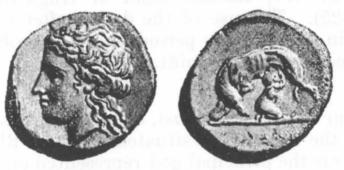
| Female head (nymph or maenad?), wreathed with ivy (Fig. 247). | ΚΥΔΩΝ Hound suckling infant (Ky-
don?). AR Stater and Drachm.
|
| Head of Athena. | ΚΥΔΩΝ Similar. AR Drachm.
|
| Female head in ivy-wreath. | Κ Three crescents (or bucranium in
place of Κ). AR Trihemiobol.
|
| Youthful head. | Three crescents. AR Obol; Hemiobol.
|
| Head of Demeter. | ΚΥΔΩ Amphora. AR Obol.
|
| Young horned head. | ΚΥ Hound seated.
AR Trihemiobol; also similar Æ.
|
| Young male head (Kydon ?). | ΚΥΔΩ Hound seated. Æ .55-.45
|
| Young male head. | ΚΥ ΔΩ Bunch of grapes. Æ .8-.55
|
| Female head. | ΚΥΔΩ Bunch of grapes. Æ .6-.45
|
Miletos, the brother of Kydon, was said to have been suckled in Crete by a wolf; a somewhat similar story may have been told of Kydon himself.
About B.C. 200 Cydonia, after a long interval, struck tetradrachms of the Athenian type (see Cnossus). Inscr., ΚΥΔΩΝΙΑΤΑΝ; symbols, Hound suckling Kydon or Zeus hurling fulmen; on the obverse, magis- trate’s name ΛΙΘΩΝ.
| Head of Artemis (Diktynna), with bow and quiver; magistrate’s name ΓΙΑΣΙΩΝ. | ΚΥΔΩΝΙΑΤΑΝ Artemis (Diktynna)
standing in hunting-dress, holding
long torch; dog beside her; whole in
olive-wreath AR Attic Tetradrachm.
|
Diktynna, elsewhere in Crete called Britomartis and more or less assimilated to Artemis, had a temple on Mount Tityrus near Cydonia (Strab. x. 4, p. 479).
| Head of Apollo. | ΚΥΔΩΝΙΑΤΑΝ Hound suckling Ky-
don. AR Drachm.
|
| Id. | ΚΥΔΩΝΙΑΤΑΝ Nike standing. Æ .85
|
| ΓΙΑΣΙΩΝ Head of Apollo. | ΚΥΔΩ Star and crescent. Æ .85
|
| Owl (inscr. ΑΓ, ΑΠ, ΑΡ, &c.). | „ Id. Æ .6-.5
|
| Head of young Dionysos. | „ Crescent. Æ .7-.55
|
Imperial—AE Augustus to Trajan (or later ?). Inscr., ΚΥΔΩΝΙΑΤΑΝ. Types—Hound suckling Kydon; Temple, &c. Also AR of Tiberius (about 119 grs.) with rev. ΣΥΝΚΛΗΤΩ ΚΡΗΤΕΣ ΚΥΔΩΝΕΑΤΩΝ ΕΠΙ ΚΟΡ ΛΥΠΩ (the Proconsul Cornelius Lupus) and ΕΠΙ ΛΑΧΗΤΙ (Laches); type, Veiled and bearded bust of the Senate; also with rev. ΚΑΙΣΑΡΙ ΣΕΒΑΣΤΩ Ε ΚΟΡ ΛΥ, Radiate head of Augustus (see also Svor., p. 116 f. and p. 325). The use of the dative after επι is noticeable; it occurs elsewhere in Crete in this period, and it is probable that all these coins were executed at the same mint.
Eleutherna (near modern Prinias), one of the most important towns in the interior of the island, was situated between Rhithymna, Sybrita, and Axus. Apollo is the principal god represented on its coins, generally in the character of a hunter (N. C., 1884, p. 28 f.).
| Apollo advancing, holding stone and bow; on r. and l., a tree. | ΕΛΕVΘΕΡ (retrograde) Artemis hun-
tress shooting with bow; in front,
dog; rude style. (Paris) AR Stater.
|
| Head of Apollo laur., sometimes within laurel-wreath (obv. and rev. often barbarous). | ΕΛΕΥΘΕΝΝΑΙΟΝ (sic), ΕΛΕΥΘΕΡ-
ΝΑΙΟΝ, ΕΛΕΥ, &c. Apollo, naked,
standing holding stone and bow.
AR Stater, Dr., ½ Dr., Obol.
Same types in Æ. |
| Head of Zeus. | ΕΛΕΥΘΕΡΝΑΙΟΝ Apollo, naked,
standing holding stone and bow [Eph.
Arch., 1889, p. 202) AR Stater, Dr.
|
| Male head (Apollo ?). | AR Trihemiobol.
|
| ΛΕ Grapes. | Apollo (as before). Æ .65
|
| Head of Apollo. | ΕΛΕΥΘΕΡ Bow. Æ .5
|
| Head of Apollo; border of dots; also with border of rays. | ΕΛΕΥΘΕΡΝΑΙΩΝ Apollo with bow,
quiver, and stone, seated on omphalos,
beside which, lyre. Æ .75-.7
|
Tiberius. Inscr., ΕΛΕΥ. AR (wt. 34 grs.), rev. Head of Augustus radiate. Struck under the Proconsul Cornelius Lupus (ΚΟΡ · ΛΥ).
Elyrus (Rhodhováni), the most important town of south-western Crete.
| ΕΛΥΡΙΟΝ Head of Cretan goat; be- neath, arrow-head. | Bee (sometimes with inscr. ΜΙ).
AR Drachm.
|
| ΕΛΥΡΙΟΝ Cretan goat standing with forefoot placed on tree. | ΜΙ Bee. AR Drachm.
|
| Head of Apollo. | [Ε]ΛΥΡΙ Cretan goat raising right fore-
foot [Myres in N. C., 1894, p. 92;
Svor., p. 310, No. 2]. Æ .7
|
| ΗΛ (for ΕΛ?) Forepart of Cretan goat recumbent, looking back; arrow-head near neck. (Also with Head of goat.) | ΗΛ Bee [N. C., 1894, p. 95; Svor.
p. 146. Specimens have been found
at Rhodhováni]. Æ .55
|
The goat is probably connected with the hunter Apollo of Crete (N. C., 1884, p. 31). The people of Elyrus dedicated at Delphi (Paus. x. 16) the representation of a bronze goat suckling the infants Phylakis and Phylandros, who were children of Apollo by Akakallis. The bee may refer to a legend connected with the infancy of Zeus (N. C., 1884, p. 33).
Gortyna (now village of ‘Αγιοι Δεκα), in the southern part of central Crete, rivalled Cnossus in wealth and importance.
| Europa riding on bull. | ΛΟΡΤVΝΟΜΤΟCΑIΜΑ (Γορτυνος το
παιμα) on the four sides of a square,
within which, lion’s scalp facing; in-
cuse square. (Others of similar types
without inscr. Also a somewhat later
didrachm with rev. inscr. ΓΟΡΤV-
ΝΙΟΝ). AR Stater.
|
| Bull recumbent. | Same inscr. as No. 1. Lion’s scalp;
incuse square [Weber Coll., N. C.,
1892, p. 198; var. in Brit. Mus.
Also Dr., ½ Dr., and Obol, without
inscr.]. AR Drachm.
|
Cf. Φαιστιον το παιμα see Phaestus, infra. Lenormant supposes παιμα to be derived from παιειν, ‘to strike,’ as κομμα from κοπτειν; cf. ΣΕΥΘΛ ΚΟΜΜΑ ‘the coin struck by Seuthes,’ supra, p. 282.
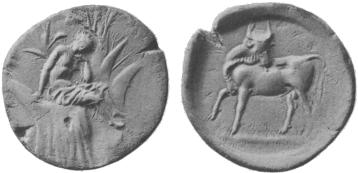
| Europa seated in tree (Fig. 248). | ΛΟΡΤVΝSΟΝ, ΛΟΡΤVΝΙΟΝ (or
without inscr.) Bull, usually standing
AR Stater.
|
Many specimens are of barbarous execution, especially on the obverse; the prototype is, however, of beautiful work. Some are restruck on coins Of Cnossus and Cyrene (obv. Zeus Ammon, rev. Silphium). The tree, though somewhat diversely represented, is probably intended for the Gortynian platanus mentioned by Theophrastus (Hist. Plant. i. 9. 5) and Pliny (xii. 1.5): ‘Est Gortynae in insula Creta iuxta fontem platanus una insignis utriusque linguae monimentis, numquam folia dimittens, statimque ei Graeciae fabulositas superfuit Iovem sub ea cum Europa concubuisse.’ On the earlier staters Europa [1] is seated in pensive atti- tude, and an eagle (Zeus) sometimes perches on a branch near her. Some specimens are inscribed ΤSΜVΡΟS =Τισυροι (?), an inscription hard to explain; according to the Scholiast on Theocritus (Num. Chron., 1891, p. 417), Τιτυρος was the name of a Cretan town. On the somewhat later series the seated Europa much resembles a figure of Hera, wearing a polos and holding a sceptre surmounted by a bird; on her knees is the eagle with expanded wings, and a bull’s head is sometimes seen in front of the trunk. It would seem that the Gortynian version of the myth was that Zeus, after carrying off Europa in the form of a bull, approached her again in the form of an eagle.
| Female head (Europa ?), wearing sphen- done; sometimes inscribed ΛΟΡΤV. | Forepart (or head and neck) of bull.
AR Dr., ½ Dr.
|
| Head of Persephone or Demeter. | Bull’s head. AR Dr.
|
1 Svoronos (Rev. belge, 1894, p. 113; cf. N. C., 1894, p. 182) considers that the figure is Britomartis seated in an oak.
| Europa seated in tree, holding out veil; on tree, eagle. | ΓΟΡΤΥ Bull standing. AR 96 grs.
|
| ΓΟΡ Id.; border of rays. | ΓΟΡΤΥΝΙΩΝ Europa seated on bull;
wreath. Æ .8-.65
|
A Gortynian decree of the third or second century B.C. enjoins, under a penalty, the use of ‘the bronze money (νομισματι τω καυχω) which the city has put in circulation’, and also fixes a fine to be paid by any one who ‘accepts in payment silver obols’ (τοδ δ’ οδελονς μη δεκετθαι τονς αργυρος); see the inscription in Journ. Int., 1898, p. 165 (Halbherr); ib., p. 173 (Svoronos); and Th. Reinach in Rev. Num., 1904, p. 12, and cf p. 465.
Tetradrachms of Athenian types (as at Cnossus, &c.). Inscr., ΓΟΡΤΥ- ΝΙΩΝ. Symbol, Bull rushing, and magistrate’s name (N. C., 1899, p. 93).
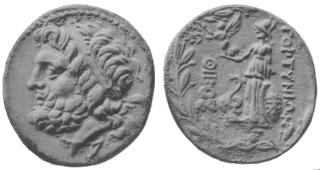
| Head of Zeus (Fig. 249.). | ΓΟΡΤΥΝΙΩΝ Athena armed standing
holding Nike; before her, serpent;
olive-wreath. Magistrate, ΘΙΒΟΣ.
AR Attic Tetradrachm.
|
| Id. | ΓΟΡΤΥΝΙΩΝ Naked male figure, with
bow and quiver, seated on rock .
AR Attic Drachm.
|
| Id. | ΓΟΡΤΥΩΝ Naked male figure (the
founder Gortys ?) advancing with
spear and shield; border of rays.
AR Dr. (Similar rev. on Æ.)
|
| Id. [Svoronos, p. 172, No. 113.] | ΓΟΡΤΥΝΙΩΝ Bull. AV 133 grs.
|
| Id. | ΓΟΡΤΥΩΝ Europa on bull AR Dr.
|
| Head of Helios. | ΓΟ Eagle holding serpent; border of
rays. AR ½ Dr.
|
BRONZE. Types—Heads of Zeus, Hermes, Artemis, Apollo; Athena holding serpent; Bull; Europa on bull (N. C., 1884, p. 38).
| ΡΩΜΑΣ Head of Roma in winged helmet, adorned with elephant’s head; in front, mon. ΚΑ. [Svor., p. 181.] | ΓΟΡΤΥΝ Ephesian Artemis (as on AV
staters of Ephesus); in field, bee and
elephant’s head; laurel-wreath [Ber-
lin, Paris]. AR Attic Tetradrachm.
|
Imperial—Inscr., ΓΟΡΤΥ, &c. Tiberius, AR rev. Radiate head of Augustus; name of Proconsul Cornelius Lupus (ΚΟΡ · ΛΥ ·). Caligula and Germanicus. Æ rev. Head of Germanicus; inscr., ΕΠΙ ΛΥΓΟΥ- ΡΕΙΝΩ. The name of Augurinus occurs also at Hierapytna and Polyrhenium. For επι with the dative see Cydonia. Trajan. Æ rev. ΓΟΡΤΥC Warrior (Gortys ?), with spear and circular shield. See also Province of Crete, infra.
Hierapytna (Gierapetra), on the southern coast, west of Cape Erythraeum.
| ΙΡ ΑΠ V between the limbs of a tris- keles; wreath. | Forepart of boar; wreath [Berlin; Svor.,
p. 188, No. 1; Z. f. N., xxi. 215].
AR Stater.
|
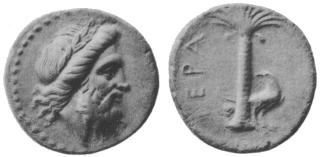
| Head of Zeus; one specimen of this type is from the same die as a stater of Eleutherna. | ΙΕΡΑ Palm-tree with eagle at its foot
(Fig. 250). AR Stater.
|
| Head of Zeus. | Id. [Svor., p. 188, No. 3].
AR about 12 grs.
|
Tetradrachms of Athenian types (as at Cnossus, &c.). Inscr., ΙΕΡΑΓΙΥ. Symbol, Eagle, or without symbol. Magistrates, ΖΗΝΟΦΙ; ΚΥΡΑΝΝΙΣ.
| Female head, turreted. | ΙΕΡΑΓΙΥΤΝΙΩΝ Palm-tree and eagle;
magistrate’s name; whole in wreath
AR Spread Tetradr. 230 grs.
|
| Id. | Id. AR Didr. 116 grs.
|
| Id. | Id. AR Dr. 57 grs.
|
Among the names on these coins are :—ΑΡΙΣΤΑΓΟΡΑΣ, ΑΡΓΑΝΩ (Eph. Arch., 1889, p. 203), ΑΣΒΑΝΤΟΣ. ΙΜΕΡΑΙΟΣ, ΚΑΟΥΜΕΝΙΔΑΣ, ΚΥΔΑΝΤΟΣ, ΜΕΝΕΣΘΕΝΗΣ, ΝΕΩΝ, ΣΑΜΑΓΟΡΑΣ, ΦΑΥΟΣ.
| Female head, turreted. | ΙΕΡΑΠΥ (on the mon. see Svor., p. 301 f.)
Palm-tree and eagle [Imhoof, Mon.
gr., p. 220, No. 51). Æ .75
|
| Head of Zeus. | ΙΕΡΑΠΥ Palm-tree; in field, aplustre
Æ .6
|
| Young male head. | Id. mag., ΣΩΤΕ. Æ .45
|
| Head of Zeus. | Ι ΑΡ Palm-tree [N. C., 1897, p. 32].
Æ .5
|
| Star. | ΙΕΡΑ and mag. Palm-tree [Svor., p.
192, No. 33]. Æ .5
|
| Young head. | Mon. of Hierapytna. Prow [Svor., p. 193,
No. 41]. Æ .4
|
Imperial. AR Divus Augustus. ΘΕΟΣ ΣΕΒΑΣΤΟΣ ΚΡΗΤΩΝ ΕΠΙ ΚΟΡΝΗΛ ΛΥ rev. ΤΑΝ (= Ζαν) ΚΡΗΑΓΕΝΗΣ ΙΕΡΑ Head of Zeus Kretagenes. Wt. about 138 grs. Tiberius. AR with Ε · ΚΟΡ · ΛΥ and ΕΠΙ ΛΑΧΗ rev. Head of Augustus radiate. Wt. about 41 grs. Caligula. AE. Inscr., ΙΕΡΑΠΥΤΝΙΩΝ ΕΠΙ ΑΥΓΟΥΡΕΙΝΟΥ or ΦΛΑΟΥΙΟΥ, rev. Eagle; in field, palm-tree.
Hyrtacina has the same types as Elyrus, to the west of which it was situated.
| ΥΡ, ΑΤΡΥ, ΥΡΤΑΚΙΝΙΩΝ Head of Cretan goat; behind, arrow-head. | Bee. AR Drachm.
|
| Goat’s head. | ΥΡ Bee, and monogram [N. C., 1894,
p. 96]. Æ .55-.45
|
Also small thin AR pieces (some specimens in gold, N. C., 1892, p. 199) recording an alliance between Hyrtacina and Lisus. Usual type: Dove (or eagle?) on obv. and rev. Inscr., Λ-Υ; ΥΡ-ΛΙ; ΥΡ-ΛΙΣΙΩΝ, or without inscr. Also types: dolphin, star.
Similar uninscribed thin AV pieces with eagle-type, &c. (wt. 10½ - 12½ grs.), procured at Polyrhenium, probably belong to Hyrtacina or Lisus (Brit. Mus. = Montagu Sale Cat., March, 1896, lot 448).
Itanus, an important town on the eastern coast.
| Sea-god (Glaukos or Triton ?), half-man, half-fish, striking downwards with trident. | Ornamented star in incuse square.
(Later specimens with wreath encir-
cling the star). AR Stater.
|
| Id. | Star. AR Obol.
|
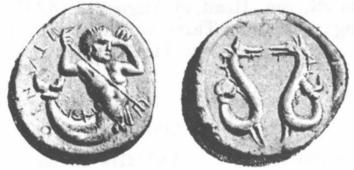
| Id. (Fig. 251). | ΙΤΑ or ΙΤΑΝΙΟΝ Two sea-monsters
face to face; incuse circle.
AR Stater, Drachm, ½ Dr.
|
| Head of Athena in Athenian helmet. | ΙΤΑΝΙΟΝ Two sea-monsters face to
face; inc. sq. [some with the name
ΕΥΦΑΜΟ instead of ΙΤΑΝΙΟΝ;
Svor. in Journ. Int., 1898, p. 157].
AR Stater.
|
| Id. | ΙΤΑΝΙΩΝ or ΙΤΑΝΙΟΝ Eagle looking
back; in field of some, small figure
of sea-god. AR Stater, Dr., ½ Dr.
|
| Id. | Star; incuse circle [see also Svor., p. 206,
Nos. 42-44]. AR Obol, ½ Obol.
|
The eagle doubtless refers to the Zeus Δικταιος worshipped at Itanus (Michel, Recueil, No. 1317; inscr. of Itanus).
Lappa (Polis or Argyropolis), an inland town of western Crete.
| Female head, r. [N. C., 1894, p. 10, No. 10.] |
Bull’s head facing; one horn turned
downwards. AR Drachm.
|
| Young head. | Similar bull’s head. AR 11-13 grs.
|
| Head of bull. | Λ. AR 11 grs.
|
Æ with bull’s head and rev. Λ or Λ![]() ; Svor., pp. 211, 212.
; Svor., pp. 211, 212.
| Head of Poseidon. | ΛΑΠΠΑΙΩΝ Trident and two dolphins
[Svor., p. 212, Nos. 11, 12]. Æ 1.0
|
| Head of Artemis. | ΛΑ Tripod. Æ .5
|
| Id. | Bull’s head with one horn turned down-
wards. Æ .5
|
Tetradrachm of Athenian types. Inscr., ΛΑΠΠΑΙΩΝ. Symbol, bull’s head with one horn turned down (Eph. Arch., 1899, p. 204, No. 39).
| Head of Apollo. | ΛΑΠΠΑΙ Apollo standing holding lyre
and plectrum. Mag. ΣΥΛΩΚΟΣ.
AR 53-45 grs. (reduced Attic
drachm).
|
| Id. | ΛΑΠΠΑΙΩΝ Lyre. Æ .85
|
| Id. | ΛΑ Lyre. Æ .55
|
Imperial. Inscr., ΛΑΠΠΑΙΩΝ, Augustus Æ, rev. Apollo standing with lyre. Tiberius AR, rev. Head of Augustus (ΛΑΠ). Domitian Æ, rev. Apollo standing; Athena; Three ears of corn. Domitia Æ, rev. Artemis with bow. Hadrian Æ, rev. Athena (Svor., p. 216, No. 35).
Latus προς Καμαρα (Svor., p. 217).
| Head of Artemis (or Eileithyia). | ΛΑΤΙΩΝ Hermes walking. Æ .55
|
| Id. [Svor., p. 220, No. 3.] | ΛΑ Bust of Hermes. Æ .4
|
There was a temple of Eileithyia at Latus (Michel, Rec., No. 28, No. 60), and Hermes was one of the gods honoured by the citizens (C. I. G., No. 2554).
Imperial. Caligula Æ, rev. ΓΕΡΜΑΝΙΚΟΝ ΚΑΙΣΑΡΑ ΕΠΙ ΑΥΓΟΥ- ΡΕΙΝΩ ΛΑΤΙ Head of Germanicus (N. C., 1891, p. 128). For επι with dative see Cydonia. For bronze coins with large Ε, &c., on rev., see Svor., p. 220 (Latos-Etera).
Lisus, in the south-west of the island (Svor., p. 222 f.), near Hyrtacina and Elyrus.
| Head of Artemis. | ΛΙΣΙΩΝ Dolphin. Æ .7
|
| ΙΛ Dove (or eagle ?). | ΑΛΕΞΑΝΔΡΟΥ Dove (or eagle ?).
AV 17 grs.
|
| Id. | Plain reverse [N. C., 1891, p. 129].
AR 9.5
|
| ΛΙ Goat’s head. | ΛΙ Bee. Æ .45
|
| Caps of Dioskuri. | ΛΙΣΙ Bow and quiver. Æ .7
|
Also alliance coins with Hyrtacina (q. v.).
Lyttus (Xyda), an important city in the eastern part of central Crete.
| Eagle flying. | ΓVΚΤSΟΝ Head and forefoot of boar;
inc. square [Brit. Mus. (Bunbury
Coll.); cf. Eph. Arch., 1889, p. 205,
Nos. 41, 42]. AR Stater.
|
| Eagle standing. | ΓVΚΤSΟN Boar’s head; inc. sq.
AR Dr.
|
| Eagle flying. | ΛVΤΤSΘN; ΛVΤ; ΛVΤΤSΘS; ΛΥΤ-
ΤΙΟΝ Boar’s head; inc. sq.
AR Stater, Dr., ½ Dr.
|
| Λ Eagle flying. | Head and forefoot of boar; inc. sq.
[Hunter Cat., ii. p. 191, No. 7].
AR Dr.
|
The eagle doubtless refers to Zeus; for it was in a cave of Mount Aegaeum, near Lyttus, that Rhea gave birth to the god (Hes. Theog., 477; N. C., 1884, p. 42).
| Boar’s head. | ΛΥΤΤΙΩΝ Eagle standing.
AR Attic Drachm.
|
| Head of Athena. | ΛΥΤ Prow. Æ .5
|
| Head of Zeus. | ΛΥΤΤΙΩΝ Eagle standing; symbol,
boar’s head. Æ .7
|
Other bronze coins with Boar’s head and Eagle types: inscr., ΛΥΤ- ΤΙΩΝ, &c.
Imperial. The autonomous coinage appears to end in B.C. 220, when
Malla (Mallasi), a town near Lyttus (Svor., p. 240). Its chief divinity was Zeus Μοννιτιος or Μονηιτιος.
| Head of Zeus. | ΜΑΛ Eagle standing. Æ .65
|
| Id. | Fulmen. Æ .5
|
Moda (? modern Μωδη, near Polyrhenium), known only from coins.
| Head of Zeus. [Svor., p. 244.] | ΜΩΔΑΙΩΝ Bull’s head facing.
AR Stater.
|
Myrina, mentioned in Plin. N. H. iv. 12. 59 (Svor., p. 245 f.).
| Bull’s head and neck. | ΜV Bull’s head and neck; circular
incuse. AR Dr.
|
| Female head; hair rolled. | Id. [N. C., 1895, p. 96. No. 11].
AR ½ Dr.
|
| Bull’s head and neck. | Μ in circular incuse. AR 16 grs.
|
Olus (mod. Επανω and Κατω Ελουντα), on the north-east coast. Its temple of Britomartis contained a statue of the goddess by Daedalus (Paus. ix. 40. 3). It had also a temple of Zeus Tallaeos (B. C. H., iii. p. 293).
| Head of Artemis Britomartis wearing laurel-wreath; quiver at neck. | ΟΛΟΝΤΙΩΝ Zeus seated holding eagle
AR 166 grs.
|
| Similar. | AR 34 grs.
|
| Similar. | ΟΛΟ[ΝΤ]ΙΟΝ Tripod. AR 20 grs.
|
| Similar. | Star. AR 11 grs.
|
| Similar. | AR 9 grs.
|
| Head of Artemis Britomartis. | ΟΛΟΝΤΙ Zeus seated holding eagle.
Æ .5
|
Also small Æ with head of Britomartis, and rev. ![]() , ΟΛΟΝΤΙ (in mon.),
&c.; symbol, dolphin.
, ΟΛΟΝΤΙ (in mon.),
&c.; symbol, dolphin.
Phaestus, west of Gortyna, one of the most ancient and important towns of Crete. Many of its types relate to Herakles, father (or grand- father) of Phaestus, the eponymous hero.
| Europa riding on bull (cf. the earliest coin of Gortyna with similar types and corresponding inscr.). | CΑIΜΤIΤIΟΝΤΟCΑIΜΑ (Φαιστιον το
παιμα) Lion’s scalp within square;
whole in incuse square.
AR Stater.
|
| CΑSΜΤS[O |
Hermes seated holding caduceus.
AR Stater.
|
| Female head (Europa). | Forepart of bull kneeling [Hunter Cat.,
ii. p. 192, No. 1, Pl. XLII. 12]
AR Stater.
|
| Herakles with bow and club standing; lion-skin hanging behind, in field. | Bull’s head. AR Stater.
|
| Id. | CΑΙΜΤΙΚΟΝ Bull feeding; legs tied.
AR Stater.
|
| Herakles standing; on l., serpent; on r., tree. | Bull tethered; laurel-wreath AR Stater.
|
| ΦΑΙΣΤΙΟΣ Herakles with club attack- ing serpent. | Bull; wreath [Z. f. N., xvii. p. 7].
AR Stater.
|
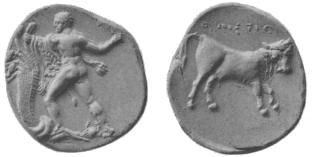
| Herakles with club attacking hydra; at his foot, crab (Fig. 252). | ΦΑΙΣΤΙΩΝ Bull. AR Stater.
|
When Herakles with the help of Iolaos destroyed the Lernaean hydra, a gigantic crab came to the assistance of the hydra and wounded Herakles in the foot (Apollod. ii. 5. 2). The bull on the coins is probably the famous Cretan bull bound by Herakles.
| ΦΑΙΣΤΙΟΝ Herakles seated, resting; bow and quiver tied to tree (or to a column); large vase beside him. | Bull walking. AR Stater.
|
| Head of Herakles. [Svor., p. 256, No. 8.] |
ΦΑΙΣΤΤΙΟ (sic) Two bulls standing r.
AR Stater.
|
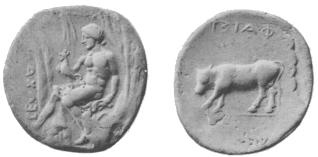
| CΕΛΧΑΝΟΣ (retrograde) Youthful male figure seated in tree; in r. hand holds a cock (Fig. 253). Zeus Vel- chanos(?), but cf. Rossbach (Rhein. Mus., n. s., vol. 44, p. 437 f.) on Hesy- chius s.v. Γελχανος. | ΦΑΙΣΤΙΟΝ (ΦΑΙΣ, ΦΑΙΣΤΙ) Bull
rushing (sometimes walking).
AR Stater.
|
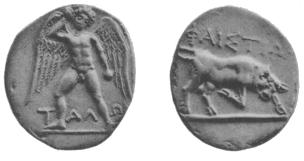
| ΤΑΛΩΝ Naked male figure winged (Talos) hurling stone (Fig. 254). | ΦΑΙΣΤΙΩΝ Bull rushing AR Stater.
|
| Similar, with dog between legs of Talos. | Forepart of bull. AR Stater.
|
| Young male head (Herakles or Phae-
stos). Also with Female head. [Svor., p. 255, Nos. 4, 5.] |
Talos hurling stone; dog between legs
[Z. f. N., xvii. p. 7, No. 2] AR Stater.
|
| ΦΛΙΣ or ΦΑ Young male bead (Hera- kles or Phaestos). | Bull’s head [Cf. N. C., 1892, p. 200,
No. 29]. AR Dr., ½ Dr.
|
| Talos running, hurling stone. | ΦΑΙCΤΙΩΝ Hound on the scent Æ .7
|
Talos (or Talon), the wondrous man of brass made by Hephaestos, was the guardian of Crete, who daily perambulated the island and hurled stones at strange vessels that approached it. The dog is doubtless the golden dog made by Hephaestos, and set as a protector to the infant Zeus in Crete, and afterwards to the temple of Zeus (N. C., 1884, p. 50 f.).
Phalasarna, at the north-west extremity of the island, possessed a temple of Artemis Diktynna and a fortified harbour (Svor., p. 268).
| Head of Diktynna, her hair bound with crossing cord. | ΦΑ Trident. AR Stater.
|
| Id.; hair rolled. | „ Id. AR Drachms ½ Dr.
(Sometimes restruck on coins of Argos.) |
| Id. | „ Id. [Svor., p. 270, No. 9]. Æ .5
|
| ΦΑΛ (mon.). (No type.) | „ Id. [Svor., p. 271, No. 11]. Æ .8
|
| Φ (No type). | Dolphin. Æ .45
|
Polyrhenium (Palaeokastro Kissámou). Its territory occupied most of the western end of the island. It had a temple of Artemis Diktynna (Strabo x. 479).
| Head of Diktynna, hair rolled (some- times with hair in coif). Signature of the engraver ΠΥΘΟΔΩΡΟΥ; see also Aptera, supra. | Bull’s head facing, with pendent fillets.
(Sometimes restruck on coins of
Argos; N. C., 1900, p. 18).
AR ½ Drachm.
|
For small AV coins sometimes attributed to this city see under Hyrtacina, supra.
| Head of Zeus. | ΠΟΛΥΡΗΝΙΟΝ Bull’s head facing, with
pendent fillets; beneath, arrow-head.
Mag., ΧΑΡΙΣΘΕΝΗΣ AR Stater.
|
| ΠΟΛΥΡΗΝΙΟΝ (and ΠΟΛΥΡΗΝΙΩΝ, Hunter Cat., II. p. 196, No. 5) Bull's head facing, with pendent fillets. | ΠΟΛΥΡΗΝΙ Spear-head. AR Dr.
|
| Head of Athena. | ΠΟΛΥΡΗΝΙ Bull’s head facing, with
pendent fillets. Æ .65
|
| Bull’s head facing. | ΠΟΛΥ, &c. Spear-head. Æ .65
|
| Round shield, on which bull’s head. | ΠΟΛΥ, &c. Id. Æ .7-.45
|
| Π Bow. [Svor., p. 281, No. 38.] | ΠΟΛΥΡΗ Arrow-head. Æ .6
|
| Boeotian shield (probably recording an alliance with Thebes). | ΠΟΛΥΡΗ Goat’s head and arrow-head
[N. C., 1894, p. 94]. Æ .6
|
| Male head, with whisker; wears taenia;
bow and quiver at neck (Philip V of
Macedon as Apollo ?). [N. C., 1884, p. 54.] |
ΠΟΛΥΡΗΝΙΩΝ Female figure (Dik-
tynna ?) seated holding Nike.
AR Attic Tetradrachm.
|
| Bust of Diktynna facing, with bow and quiver. | ΠΟΛΥΡΗΝΙΩΝ Apollo (?) advancing
with bow. AR ½ Attic Dr.
|
Tetradrachms of Athenian types (as at Cnossus, &c.). Inscr., ΓΙΟΛΥ- ΡΗΝΙΩΝ. Symbol-Artemis shooting with bow. Also Æ with types referring to Apollo and to Hermes (Svor., p. 282 and p. 283), and Æ with obv. Head of Athena, rev. ΓΙΟΛΥ Owl. (Svor., p. 283, No. 50.)
Imperial. Augustus. ΘΕΟΣ ΣΕΒΑΣΤΟΣ ΕΠΙ ΚΟΡΝΗΛΙΟΥ ΛΥΠΟΥ Radiate head of Augustus, rev. ΤΑΝ (cf. Hierapytna) ΚΡΗΤΑΓΕΝΗΣ ΠΟΛΥΡ Head of Zeus Kretagenes laur.; beneath, fulmen. AR Wt. 147 grains (Paris, Svor., p. 284, No. 52). Caligula. Æ with rev. Head of Germanicus. ΕΠΙ ΛΥΓΟΥΡΕΙΝΩ ΠΟΛ. For επι with dative see Cydonia.
Praesus (Annual of Brit. School at Athens, viii. 1901-1902, p. 231 f.). The territory of this city occupied the greater part of the eastern end of Crete, bordering upon that of Itanus. The city was destroyed by the Hierapytnians some time after B.C. 148. Several coins refer to the worship of Zeus Δικταιος, whose temple stood on Mount Dikte east of the town.
| Gorgoneion. | Youthful figure (Herakles ?) in chlamys,
kneeling and shooting with bow; in-
cuse square. AR Stater.
|
| Cow suckling infant (Zeus ?). | ΠΡΑΙS Herakles (?) kneeling and shoot- ing with bow [Svor., p. 286, No. 2 (Paris); N. C., 1896, p. 18 (Weber Coll.)]. |
| Youthful figure (Herakles ?) in chlamys, kneeling and shooting with bow. | ΠΡΑΙS Eagle; incuse square.
AR Stater, ¼ Dr.
|
| Zeus Diktaeos enthroned, holding eagle and sceptre. | ΠΡΑΙ Bull butting [B. M. C., Crete,
‘Praesus,’ No. 5; cf. N. C., 1892,
p. 30]. AR Stater.
|
| Zeus Diktaeos (as above). | Forepart of goat looking back.
AR Stater and Dr.
|
| Id. | ΠΡΑΙ Herakles standing wielding club
and holding bow [Svor., p. 288, No.
21]. AR Stater.
|
| Head of Apollo. | ΠΡΑΙ AR Stater.
|
| Id. | ΠΡΑΙΣΙΩΝ Herakles with club and
bow (as above). AR Stater.
|
| Id. | Goat’s head in laurel-wreath AR ½ Dr.
|
| Id. | Bull’s head. AR ½ Dr.
|
| Head of Demeter or Persephone wreathed with corn (as on Syracusan coins). | ΠΡΑΙΣΙ Rushing bull; symbol, rose.
AR Stater.
|
| Id. | ΠΡΑΙΣΙΟΝ Bull’s head; symbol, rose.
AR Dr.
|
| Id. | ΠΡΑΙΣΙ Bee; symbol, rose AR ½ Dr.
|
| Head of Apollo. | Bee. AR ½ Dr.
|
| Id. | ΠΡΑΙCΙΩΝ Fulmen. Æ .7
|
Priansus, probably an inland town in the valley of the Katarrhaktes, near Mount Dikte (Svor., p. 293).
| Goddess enthroned beneath palm-tree, caressing serpent which rises to her hand. | ΠΡΙΑΝΣΙΕΩΝ Poseidon in himation
standing holding trident and dolphin.
AR Stater.
|
| Similar. | Forepart of goat looking back; in field,
arrow-head [Svor., p. 296, No. 6]
AR Stater.
|
| Female head (Artemis ?). | ΠΡΙΑΝΣΙΕΩΝ Palm-tree between dol-
phin and rudder. AR Dr.
|
| Id. | ΠΡΙΑΝΣΙΕΩΝ Trident. AR Dr.
|
| Id. | AR .65
|
The goddess fondling the serpent may be Persephone approached by Zeus in the likeness of a serpent (cf. coin of Selinus in Sicily, supra, p. 169; N. C., 1884, p. 56), or possibly Hygieia, for there was a temple of Askle- pios at Leben near Priansus.
| Female head (Artemis?). | ΠΡΙΑΝ Poseidon striking with trident
Æ .65
|
| Id. | ΠΡΙΑΝCΙWΝ Palm-tree between rud-
der and dolphin; border of rays. Æ .7
|
Rhaucus lay between Gortyna and Cnossus. Though an inland town, it had a cultus of Poseidon, like Mantineia, the various Thessalian towns, &c. Circ. B.C. 166 Cnossus and Gortyna made a combined attack upon Rhaucus and divided its territory between them (Polyb. xxxi. 1).
| Poseidon Hippios, naked, holding trident and standing beside his horse (horse's foot sometimes on prow). | ΡΑΥΚΙΟΝ Trident (on the earlier
specimens within incuse square).
AR Stater.
|
| Head of Poseidon; trident at shoulder. | ΡΑΥΚΙΟΝ Trident between two dol-
phins. AR Dr.
|
| Head of Poseidon. [Svor., p. 307, No. 24.] |
ΡΑΥΚΙΟΝ Two dolphins. AR ¼ Dr.
|
| Head of Demeter or Persephone. | ΡΑΦΙΩΝ Head of trident AR Obol.
|
| ΡΑΥΚΙΩΝ Horse’s head. | Dolphin and trident. Æ .7
|
| Head of Poseidon. | ΡΑΥΚΙΩΝ Trident between two dol-
phins. Æ .8
|
| ΡΑΥΚ Two dolphins. | ΡΑ Head of trident. Æ .45
|
| ΡΑΥ Dolphin. | Head of trident. Æ .45
|
Rhithymna (Rethymnos), on the northern coast.
| Head of Apollo. | ΡΙ Apollo holding stone and bow.
AR Stater.
|
| Head of Athena. | ΡΙ Trident between two dolphins.
AR Dr.
|
| Id. | ΡΙ Trident. AR ½ Dr.
|
| Id. | ΡΙ (or ΡΙΘΥ) Two dolphins. Æ .55
|
| Id. | ΙΡ Trident. Æ .55-.4
|
Sybrita, an inland town, south of Eleutherna.
| Dionysos, bearded, seated, holding kan- tharos and thyrsos. | ΣΥΒΡΙΤΙΟΝ Hermes standing, holding
phiale and caduceus [Svor., p. 314,
No. 1]. AR Stater.
|
| Similar. | ΣΥΒΡΙ Similar [Ib., No. 2] AR Dr.
|
| Head of Dionysos, bearded and wreathed with ivy; in front, grapes. | ΣΥΒΡΙΤΙΩΝ Head of Hermes; in
front, caduceus [N. C., 1890, p. 321,
No. 20]. AR Stater.
|
| Similar. | Similar type [N. C., 1 895, p. 97, No. 14].
AR Dr.
|
| Young Dionysos holding thyrsos, riding on galloping panther. | ΣΥΒΡΙΤΙΩΝ Hermes, wearing chlamys,
stooping forward and placing his foot
on a rock, while he ties his sandal;
in front, caduceus. AR Stater.
|
| Head of young Dionysos wreathed with ivy; behind, grapes. | ΣΥΒΡΙΤΙΟΝ Hermes, standing holding
long caduceus [Hunter Cat., II. p.
199, No. 31. AR Stater.
|
| Apollo (?) seated on rock adjusting bow. | ΣΥΒΡΙ Head of Hermes; petasos at
neck [Svor., p. 315, No. 7]. AR Dr.
|
| Head of young Dionysos. | ΣΥΒΡΙΤΙΩΝ Goat’s head and spear
[Brit. Mus. = Eph. Arch., 1889, p. 210,
No. 60]. AR Dr.
|
| Head of goat. | ΣΥ Grapes [Similar types on Æ without
inscr.; Eph. Arch., 1889, p. 210.
No 62]. AR Obol.
|
| Top of caduceus. | ΣΥ (in mon.) within incuse square.
AR ½ Obol.
|
| Head of Hermes. | ΣΥΒΡΙ Caduceus. Æ .7
|
| Id. | ΣΥΒΡΙΤΙΩΝ Jawbone of animal Æ .5
|
| Head of Zeus. | Similar. Æ .8
|
| Id. | ΣΥ Spear-head and branches [Svor.,
p. 316, No. 15]. Æ .35
|
| ΣΥ Dolphin. | Trident in wreath [Hunter Cat., II.
p. 199, No. 5]. Æ .5
|
Tanus, mentioned only by Steph. Byz. (Svor., p. 318).
| Head of young Dionysos. | ΤΑΝ Globule between three crescents.
AR Obol.
|
| Young male head, r. | ΤΑΝΙΤ Head of Hermes. AR Obol.
|
Tarra, on the south-west coast, not far from Elyrus, Lisus, and Hyrtacina.
| ΤΑΡ Head of goat; beneath, arrow- head. | Bee [N. C., 1896, p. 19]. AR Drachm.
|
| Head of goat. | Æ .4
|
The people of Tarra worshipped an Apollo Ταρραιος (Steph. Byz., s.v., Ταρρα), to whom the goat’s head may refer (cf. under Elyrus and Hyrtacina, supra).
Tylisus (Επανω and Κατω Τυλισω), on the north coast between Rhaucus and the sea.
| Head of Hera wearing stephanos adorned with floral devices. | ΤΥΛΙΣΙΟΝ and ΤΥΛΙΣΙΩΝ, some-
times retrograde. Apollo, naked,
standing holding goat’s head and
bow; in field, shrub, or arrow-head
[Variety with ΤΥΛΙΣΙΟΣ; Svor.,
p. 330, No. 10]. AR Stater.
|
| Cista mystica with serpent; ivy-wreath. | ΚΥΔΑΣ ΚΡΗΤΑΡΧΑΣ ΚΡΗΤΑΙΕΩΝ
Between two serpents, Zeus Kreta-
genes standing holding eagle and hurl-
ing fulmen [Svor., p. 334, No. 1]
AR Cistophorus.
|
Probably struck at Gortyna between B.C. 66 and the battle of Actium, B.C. 31.
Imperial—Caligula to Antoninus Pius, chiefly Æ, but there are AR of Caligula, Claudius, &c.; weights, 160 grs. (Didr.), 120 grs. (1½ Dr.), 45 grs. (½ Dr.). There are also AR, reign of Nero, probably of Crete, inscribed ΑC · ΙΤ · ΚΔ (Assaria Italica 24?)=the drachm, circ. 84 grs., and ΑC · ΙΤ · ΙΒ (Assaria Italica 12?) = ½ dr., circ. 37 grs. (Brit. Mus., Imhoof, G. M., p. 687 f.). Inscr. Coins of the earlier emperors give no indication of the place of issue, but from the reign of Domitian, ΚΟΙΝΟΝ ΚΡΗΤΩΝ or Κ Κ appear. Chief types—Augustus, radiate, seated in curule chair or in car drawn by four elephants; around, seven stars (the Great Bear). The Korybantes dancing. ΖΕΥC ΚΡΗΤΑΓΕΝΗC standing hurling fulmen; around, seven stars (Svor., p. 342, No. 45; R. N., 1898, p. 677 f.). ΔΙΟΣ ΙΔΑΙΟΥ Eagle. ΔΙΟΣ ΑΓΟΡΑΙΟΥ Altar. Nymph holding infant Zeus (Svor., p. 346, No. 74). Infant Zeus seated on globe; near him, goat; around, seven stars. Europa on bull. Artemis. ΔΙΚΤΥΝΝΑ ΣΕΒΑΣΤΗ Diktynna hunting (Svor., p. 343, No. 55). ΠΑΡΘΙΑ seated and trophy. Emperor, Nike, and ΑΡΜΕΝΙΑ captive. ΔΑΚΙΑ Dacia captive. The warrior ΓΟΡΤΥC. Altar. Tripod, &c.
See Svor., pp. 331, 332, also p. 121 (Dictynna); p. 147 (Eltyna?); p. 150 (Heracleion ?); p. 272, cf. Eph. Arch., 1889, p. 209, No. 52 (Poekilasos ?); p. 326, cf. Eph. Arch., 1889, Pl. XIII, No. 14 (Thenae?); Eph. Arch. 1889, p. 206 (Orion?); Svor., p. 319, No. 1 (Tanos or Cydonia:— uninscribed didrachm with obv. fine head of young Dionysos, rev. Tripod). Didrachm (of Priansus ?), N. C., 1895, p. 96. Didrachm, obv. male figure seated in tree holding wreath; rev. Apollo seated in laurel-tree holding lyre (Hunter Cat., II. Pl. XLIII. 7). See also Hunter Cat., ‘Uncertain,’ II. p. 200 f. (No. 3, p. 200 is now recognized by Macdonald as a coin of Etruria; op. cit., III. p. 748).